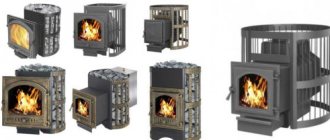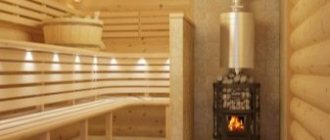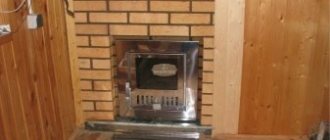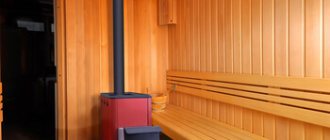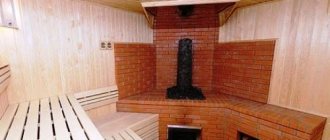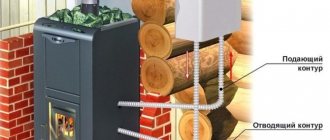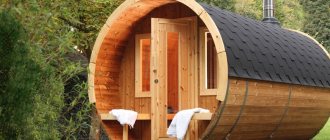Modern summer residents, when choosing a stove for a bath, increasingly prefer metal ones. Moreover, offers from manufacturers are becoming more and more diverse. Choosing a good, powerful stove for a sauna means completely ensuring a comfortable stay. If the stove is bad, cannot cope with the load, and does not supply the required amount of steam, then even in a well-equipped room, the heating result will be questionable. The power of the sauna installation must be high, because its goal is to heat the steam room to a high temperature as quickly as possible.
Cast iron and steel are the main materials for the manufacture of sauna stoves
Metal sauna stoves are made of cast iron or steel. They are produced in several types, depending on the material:
- cast iron stoves;
- steel made of black heat-resistant steel;
- steel from alloyed stainless steel.
These materials are iron-carbon alloys. They differ in different carbon content. The strength and ductility of steel, which contains at least 45% iron, is determined by the carbon content of up to 2%. Cast iron has more than 2% carbon. Therefore, it is heat-resistant, but less durable. Which sauna stove is better: cast iron or steel? Each option has its advantages and disadvantages.
Maintainability
As for maintainability, it is better to repair a stove made of steel. Repairs are made using conventional welding. However, a seam made by an unprofessional welder will most likely not bring the desired benefit, but rather the opposite. Loss of the firebox geometry will lead to the need to completely replace the sauna stove. Repairing a cast iron stove by welding will not work at all.
Cast iron is generally difficult to repair. However, if the cast iron stove initially has a prefabricated structure, then the part in need of repair can simply be replaced with a new one, if this is provided by the manufacturer.
Another advantage of cast iron is its resistance to corrosion. He is practically not exposed to it. An oxide film simply forms on the surface of cast iron, protecting it from the spread of corrosion. Destruction does not go deep into the metal. This wonderful effect is also known as passivation. Steel can also resist corrosion, but thanks to alloying. The final price of the furnace directly depends on the number of alloying elements in the composition.
Advantages and disadvantages of a stove made of cast iron
A cast iron stove attracts buyers, first of all, with its good thermal conductivity and durability, and is considered the best offer for a bathhouse. It has a sufficient number of advantages:
- Cast iron can maintain temperature for a long time due to its loose structure. Furnace efficiency is 82%. This is better than steel and brick structures. Due to the weight and thick walls (up to 10 mm), the temperature in the room is maintained for a long time. One portion of firewood placed in the stove will be enough for 6-7 hours of the heating process.
- Cast iron stoves are heat-resistant, can withstand high temperatures more easily, and their coefficient of linear expansion is much lower than that of steel ones, that is, they hardly deform during heating. Such stoves do not burn out because they do not oxidize.
- A product made of cast iron does not rust, and therefore does not require special care - anti-corrosion coatings, heat-resistant painting, tiling, brick cladding. Although all this is done at the request of the consumer, it is more for design purposes.
- The appearance of a cast iron stove can be particularly sophisticated, which also attracts buyers. Carved or glass doors, various shapes - all this is available to equipment owners.
- The fire safety of a cast iron stove is higher than that of a steel stove. The stove structure can easily withstand high temperatures without the formation of small cracks through which sparks can fly into the living room.
- The durability of the stove, made of high-quality gray cast iron with a wall thickness of 10 mm or more, is beyond doubt. Such equipment will serve its owners for up to 35 years.
As for the disadvantages of an expensive product, the main one is the fragility of the structure due to the increased carbon content. A stove made from sheet cast iron of low quality does not withstand temperature changes well and can break or burst upon impact. Imagine a bathhouse in which, during peak heating, cold water hits the stove. There will be an instant temperature change, the furnace will burst and it will be impossible to repair it, since the parts must be cast. Bathroom equipment made of high-quality gray cast iron (models Hephaestus, Svarozhich for baths with a volume of 25-45 m³ and Ermak for a steam room, sizes up to 12 m³) invariably delight customers.
Nuances of choice
How to choose a convenient stove model and not make a mistake. Classic cast iron sauna stoves have a heater above the firebox; in the upper part of the body there may be a tank for heating water of 20-30 liters
To choose the right design correctly, you should pay attention to the following points:
- Fuel type. In addition to traditional models that run on wood or gas, there are also electric ones, the operation of which is easy and convenient.
- Performance. It is selected based on the volume of the steam room in the bathhouse. The accompanying documents contain information about the capacity of the cast iron stove.
- Firebox location. Modern cast iron models have two versions: regular or extended firebox. In the latter case, the stove is installed in a wall opening, allowing firewood to be loaded from the dressing room, which is considered the most optimal solution for a bathhouse.
- Material. For the production of stoves, cast iron of various qualities and thicknesses is used. These parameters directly affect the service life of the heating structure for the bath. Consumer reviews give preference to the Sudarushka M cast iron stove model.
- Water container. There are various design options for cast iron stoves with a tank. It can be mounted or built-in, the mount is located on the side, behind or directly on the chimney. You can choose a suitable model for a bathhouse based on the parameters of the steam room.
- Glass door. If you want to become the owner of a cast iron stove with a beautiful design, it is better to choose a model with a glazed door. After all, you can watch the flames endlessly. It is worth noting that such beauty will increase the cost of a cast iron stove.
Functional features of cast iron stoves
Some features of the operation of cast iron structures:
- The difficulty of repairing a cast iron stove. Parts for restoring the product can only be ordered from the manufacturer, since the main method of manufacturing cast iron elements is casting.
- Cast iron is a heavier material than steel. Stoves are heavy (200 kg or more). Not only is such a stove difficult to transport to its destination, but its installation will also require appropriate efforts and conditions.
- To install the equipment, it is possible to manufacture a special base for the furnace.
- The parts of a cast iron stove are connected using tongue and groove type locks. For some products, modern special sealants are used that can withstand high temperatures well.
However, cast iron stoves have been very popular for many years. Not only simple products were cast from cast iron, but also antique, real objects of art. Of course, casting was complicated: a drawing and model were created, according to which the necessary parts were made.
Safety
The bathhouse is a source of increased danger. Baths are traditionally heated with wood; the stoves have an open firebox, into which additional fuel is constantly added. To ensure safe operation, a platform made of non-combustible material for falling coals must be constructed in front of any fireboxes.
If we talk about the safety of people in the bathhouse, then the stone or brick version of the stove wins here. If you touch such equipment, a person will receive a slight burn, and if you touch a red-hot metal stove, then the marks from such contact will heal for a very long time.
This feature of brick stoves is determined by the ability of the material to evenly distribute heat throughout its entire volume, due to which the heating of the air and an accidentally outstretched hand does not occur so sharply.
All stoves in places of contact with wooden walls are lined with non-flammable materials: basalt or Kevlar. Thanks to this, the wood does not heat up, fire does not reach it and the risk of fire is reduced.
Advantages and disadvantages of a furnace made of black heat-resistant steel
Steel is a more durable and ductile material than cast iron. Freely cut, stamped, welded. Its heat transfer is higher than that of cast iron. Steel stoves are constructed from different types of steel - black steel or stainless steel. Features of the ferrous metal stove:
- It has low heat transfer, requires a lot of time and fuel to heat up, and cools quickly. Tolerates high bath temperatures well.
- Short-lived. Under the influence of elevated temperatures, the oxidation process in low-carbon steels is activated, and the metal “burns out.” Experts estimate the service life for such a furnace to be 2-3 years.
- The structural frame of the furnace expands greatly at high temperatures, so that sometimes you can observe the process of bursting welds.
- Requires additional treatment with heat-resistant materials.
- The cost of a furnace made of such metal is low.
Range of offers on the market
- Cast iron and steel stoves, combined heating devices;
- Household stoves, fireplaces, heating and cooking stoves;
- Chamber, bell-type and channel furnaces;
- Shape: round, barrel-shaped and rectangular;
- By color: black, steel, patina, bronze, anthracite and others - more than 50 colors and shades;
- Standard stoves with a door without glass, as well as fireplace stoves with glass, double glass, prismatic or panoramic glass;
- By fuel type: firewood, briquettes, pellets, coal, combined options;
- By type of heating: radiant heating, convection, with warm air distribution, with the ability to connect heating radiators;
- In terms of power, on average, from 1-3 kW and up to maximum values, depending on needs;
- To meet the requirements of smoke removal systems with chimneys of various diameters;
- Furnaces with or without an ash pan, with or without grates, with different connections for chimney ducts, standard and with fireclay inside, equipped with a clean glass system or an air supply, equipped with a double afterburning system, with temperature and power control, equipped with automatic equipment.
Characteristics of a stainless steel furnace
The popularity of stainless steel stoves has now increased, since steel manufacturers set a shelf life for some models, as for cast iron structures - 20 years. Specific features of the buildings:
- Alloy steel stoves heat up quickly and release heat to the bathhouse earlier than cast iron ones, although they do not tolerate overheating well. The thickness of the oven walls is from 4 to 10 mm, so they are often lined with bricks to increase the duration of heat maintenance. Due to this, stoves retain heat for a longer time.
- The installation economically consumes combustible materials - firewood, coal.
- Stainless steel contains 12% alloying elements, so it almost does not suffer from oxidation processes during combustion. Only welds from which alloying additives have evaporated during welding are susceptible to oxidation.
- Thermal expansion remains one of the disadvantages, and at high temperatures the geometry of the structure can be disrupted. In order to weaken this effect, stiffeners are welded onto 4-5 mm of the furnace wall. This, of course, improves the situation, but also increases the weight of the stove.
- Steel stoves have a simpler design compared to cast iron, and are small in size and weight.
- Since steel is an easy-to-process material, many people make the device themselves. It is much easier to make a product from steel than from cast iron. It is enough to cut out the elements, weld them, and further process them – the oven is ready.
Steel and cast iron stoves have their advantages and disadvantages. Therefore, experts are trying to combine two options into one, creating equipment in which, for example, the firebox is cast iron, and the body is made of steel. This is how the “Fire Bird” and “Slavyanka”, “Kalita” and “Sudarushka” models are designed, which combine cast iron parts with stainless steel elements. When choosing which stove is better, cast iron or steel for a summer residence, you should focus on the main indicators - the degree of heat transfer and durability. According to this approach, cast iron stoves are superior to steel ones. Although modern manufacturers of steel furnaces have practically leveled this inequality, creating models that are durable, powerful, high-quality and at the same time cheap. Professionals give preference to foreign models of steel or cast iron stoves, justifying their choice with the high quality of the products. Advantage is given to Finnish models from the oldest manufacturer with 60 years of experience in the stove market. For example, Helo 16 KL VP Sl is excellent for small steam rooms. The model is reliable, its quality is time-tested. In conclusion, it is worth saying that all stoves - both steel and cast iron - are available in gas, electric and wood. Wood-burning ones are the most popular. The spirit of the tree in the steam room creates a unique forest atmosphere, which promotes complete relaxation and rest.
Design selection
To choose the right stove, it is important to understand how it will be used in accordance with the technical parameters of the room. According to the method of placing stones, furnaces are divided into open and closed.
According to the method of placing stones, furnaces are divided into open and closed.
- A stove with an open method of placing stones is intended for steam rooms, which are designed for the simultaneous stay of several visitors. The stones are placed in a firebox that does not have special heat-resistant protection. The open method of placement helps to quickly warm up the air in the room, with the temperature of the stones reaching 180 degrees. Most often used in electric heaters.
- A closed firebox is designed for traditional Russian steam rooms. The maximum number of stones is used here, and the structure is protected by a special door. During the combustion process, the door remains closed, which does not interfere with the penetration of steam into the room.
Based on the heating temperature of the outer walls, stoves can be cold or hot.
- In hot heaters, the air temperature reaches 100 degrees, for this reason it is recommended to install such equipment in any steam rooms, as well as rooms in which there are no other heating options.
- The heating temperature of the walls in cold fireboxes does not exceed 50 degrees, and the air in the room is heated through special channels through which cold air enters the heater and returns hot. The channels allow you to correctly adjust the temperature.
According to their design features, fireboxes come in constant and direct heating.
- Direct heating units (periodic) are designed in such a way that heated stones can accumulate heat over a long period of time. The heating process takes up to 10 hours, and bathing procedures begin after its completion.
- Constant heating devices (continuous) require fewer fire stones and heat the air to medium temperatures.
There are also combined options - brick fireboxes using liquid fuel. It is good to heat such a stove before and during basic health procedures.
With your own hands
Combination - an iron stove and a brick pipe that accumulates heat, laid out with your own hands by a non-professional
Here we will not go into the details of making sauna stoves yourself. However, it is worth noting that it is quite difficult to build such a stove yourself out of brick, or rather, it is difficult to do it correctly.
In fact, would the work of a professional stove maker be so highly valued if anyone could install a brick stove using online schemes? Every craft has its secrets.
We admit that a person with many years of experience in bricklaying can try his luck with his own stove. Beginners should practice on something simpler.
By the way, brick for this purpose cannot be silicate or hollow. This is necessarily a fire-resistant solid ceramic brick, in particular fireclay, which is used inside the furnace. The mortar used for masonry does not contain cement, it is a mixture of clay and sand.
It is easier to weld a metal stove than to install a brick one yourself. Think carefully about what protection you will have from its excessive heat.
And do not forget that it is better to make a heater not just closed, but with direct fire. Of course, this will force you to change stones much more often than if they were in a solid metal box, but tradition has not only advantages.
Stone
To install a stone stove yourself, you will have to try hard, but the result can exceed all expectations:
- First you need to choose a location to install the equipment.
This can be the center of the house, then the heating will be distributed as conveniently as possible throughout the living space. The fireplace stove is located in the side of the common room, where it simultaneously heats the space and gathers household members around it. When the stove is located in the center of the house, it is allowed to intersect with partitions dividing the space into rooms. - After determining the installation location, it is necessary to install the foundation.
- While the concrete gains maximum strength, and this process takes 4 weeks, you can worry about purchasing the necessary materials:
- Firebricks are excellent for lining the firebox and the inner surface of the pipe. This material is able to withstand extremely high temperatures and at the same time retain all its properties.
- Ceramic materials are used to construct the rest of the furnace. They accumulate thermal energy well and, as befits a stove, release it into space.
- Sand-lime bricks are not suitable for stoves; it is better to leave it for decorating the facade of the house.
- After selecting the basic materials, you need to buy fittings, including grilles, doors, handles and a poker.
- Before starting work, stove makers are advised to pre-assemble the entire structure without mortar, make sure that there are enough materials and the stove turns out as intended, and only after that can you start laying.
- First, lay the base - the base layer. During these works, you can use mortar, sometimes instead of bricks it is filled with crushed stone.
- When laying the first row, it is especially important to monitor the position of the bricks in space. The line of the outer wall must be strictly parallel to the ground and walls. You can check this using a level. The more often the master applies the level, the better the quality of the oven.
- The furnace wall that will be closest to the wall should be equipped with a second layer of brick to create additional protection against fire and excessive heating of combustible materials.
- The removal door is installed using mortar in the second or third row.
- There is a grill over the small door.
- After this, a large door leading into the firebox is installed; it serves to store firewood and should allow fuel to be placed inside without any problems.
- Dampers must be installed in the chimney.
After completing the work and installing the pipe, the work can be considered completed. Now all that remains is to remove the construction debris, let the mortar set and begin trial kindling.
Is weight a guarantee of quality?
For both cast iron and steel stoves, the quality of the metal is primarily important. This characteristic affects safety. Experts warn that unscrupulous manufacturers who save material may have their firebox burn out - and this threatens not only the need for repairs, but also a much more serious problem - a fire.
“For example, a real cast-iron sauna stove is heavy - at least 100 kilograms. If one person can lift it and calmly carry it, then we do not recommend installing such a stove,” advises Zhiglov.
Measurements of the cast-iron “Sibir” showed that the metal thickness of the body is 12 millimeters, and in the upper part, which bears the main load, 15 millimeters. The steel model is also thick—6 millimeters thick metal is used throughout the entire structure, and not just in the firebox.
Price
Another criterion that concerns future stove owners is its cost.
The cheapest option is a steel stove. Not only does it cost a little, but it also does not require additional steps on the part of the installer. They can be located on the floors of the first floor, which makes such stoves very cheap. However, in bathhouses the iron stove is often lined with bricks.
This is done to increase its heat capacity. Such heating devices can retain heat longer than their “naked” counterparts. Thanks to the uniform distribution of thermal energy, the stoves will not be very aggressive to careless touches, but even a stove lined with brickwork is not recommended to be touched.
The average price is a cast iron stove; a high-quality model is several times more expensive than the steel version. Such structures require additional arrangement of the site to evenly distribute the load over the base.
Stone stoves for the home will cost the largest amount. This is due to the skill of the stove maker. It has been very difficult to find real professionals in their field lately; they are usually called on the advice of friends. Only when working with a trusted person can you hope for his conscientious work.
Installation Requirements
To install the stove correctly, you need to take into account a number of requirements:
- The minimum distance between the firebox and the walls of the room is 50 cm. Wooden surfaces are covered with heat-resistant material with a layer of aluminum foil on the front side.
- The base for the oven must be made of heat-resistant material. The dimensions of the foundation must exceed the dimensions of the stove by 10 cm on each side.
It is impossible to imagine a classic Russian bath without a stove. The choice of stove equipment is an important stage in the construction of bathhouses. To obtain the required level of performance, optimal temperature, humidity, a number of factors and requirements must be taken into account.
Why do glasses crack?
The different sensations in the steam room depend on the type of heater. “In a closed heater, water is poured back, enters the distributor and falls to the lowest stones, splits, and when the steam leaves the stove, it is almost invisible. In the steam room, the temperature remains the same, the humidity rises - this is convenient for sitting with a broom. An open heater produces regular dry steam, like in a Finnish sauna,” Dorovsky describes the differences between the heaters.
Fireplace-type stoves with glass doors decorate the rest room. But if aesthetics are not important or the bathhouse is heated from a special room, it is better to choose a simple door. The expert clarifies that glass with any design will still have heat loss, and cast iron or metal will leave all the heat inside.
It is not recommended to burn stoves with glass doors with coal, since its combustion temperature is 900 degrees, and the material will only withstand 350-400 degrees. The maximum that is possible is to add one blade to the firewood.
“It happens that glass doors from some manufacturers need to be washed constantly because soot settles on them. Our designers came up with a special air curtain, thanks to which soot does not reach the glass and it does not smoke,” says a representative of the NMK plant.
If the glass cracks after the first fire, then this is a manufacturer’s problem - it means that the glass is pressed by a point metal fastener, which expands when heated. Typically installers loosen the mounting bolts before the first burn and then tighten them again.
Efficiency
Installation efficiency is the main criterion that matters to owners of a bathhouse or home. There are several parameters by which the quality of the device is assessed:
- Depending on the heating rate, one of the options is chosen: a steel stove will warm up the room in a time not exceeding half an hour, it will take about an hour to receive heat from a cast iron stove, and a stone stove made of ceramic bricks will first heat itself and only then begin to warm up the surrounding space.
- For steam rooms of different sizes, you should choose different materials for stoves. A large volume can be efficiently heated using a brick stove, while a cast iron stove is suitable for small steam rooms. Very small spaces can be entrusted to steel models; the volume heated by them is limited to 30 m3.
- The duration of cooling is important if many people take turns washing in the bathhouse or the owners do not want to constantly add another portion of fuel. The stone brick option will work best in this case. Such stoves can retain heat for about 12 hours. In this case, you can light the stone stove for your home once, and at the same time it will maintain a comfortable temperature. Steel models cannot boast of such good characteristics; they cool down almost instantly and the owners have to constantly add fuel throughout the entire time they are in the bathhouse or country house. Cast iron items may retain their heat a little longer, but they will still cool down after an hour.
- Steel or cast iron stoves can heat water by having a water tank. When using brick buildings, you will have to take additional care of the availability of hot water in the steam room or in the house.
The operating principle of the furnaces is also different. Cast iron and steel models heat the nearby air, according to the laws of physics it rises, and cold air comes in its place, after which it also heats up, rises and this process is repeated again. From this we can conclude that constant circulation of air masses in the room is necessary.
Unlike cast iron, brickwork is capable of not only heating the cold air touching it, but also using infrared radiation to increase the temperature of all objects in the room.
Review of the best models
After reading the information on forums and customer reviews, we can identify several popular models of stoves for bathhouses:
- Vesuvius Legend. Suitable for heating steam rooms with a volume of 14–24 cubic meters. The maximum heating temperature of the stones is 500 degrees. With this heating, you can easily obtain dry steam. The average price is 25,000 rubles.
- Zharnitsa. Made from structural steel. It has a water tank, which is located close to the firebox. Tank capacity - 45 liters. The average price is 14,700 rubles.
- Skif standard. Suitable for heating a steam room with a volume of 14 cubic meters. The fuel combustion chamber is made of structural steel. The average price is 12,500 rubles.
- Optimal standard. Suitable for heating rooms with a volume of 6–14 cubic meters. The door and grate are cast iron. The average price is 9600 rubles.
- Rusich Anthracite. Suitable for heating steam rooms with a volume of up to 14 cubic meters. With its help, you can choose the Russian or Finnish bath mode. The average price is 14,000 rubles.
- Lava 22. Used in steam rooms with a volume of 12–24 cubic meters. The combustion chamber is made of structural steel. The average price is 15,700 rubles.
- Lava 12. Used for heating steam rooms with a volume of 6–14 cubic meters. It works in two modes - classic Russian bath, Finnish sauna. The average price is 13,500 rubles.
- Karelia 5. A classic stove, which is heated from the steam room, which creates some inconvenience. Can heat a steam room with a volume of up to 20 cubic meters. The average price is 30,000 rubles.
Manufacturers of metal units for baths
How to choose cast iron wood-burning stoves for a bath: top 8 models with descriptions of technical characteristics and distinctive features
If the question arises, what are the best stoves for a sauna with a closed heater, then it is worth talking about the most popular and proven products. They are present in the lines of the following manufacturers: Vulcan, Teplodar, Termofor (read: “How to choose and install a Vulcan stove for a sauna”). There are also devices with a closed heater from Finnish companies.
The following enterprises produce metal stoves for Russian baths:
- Fehringer;
- Kutkin;
- Teklar;
- Troika;
- Kalita;
- Svarozhich;
- Enchantress;
- Isistim;
- Sudarushka.
Manufacturers who are in the top four have already earned a positive reputation - customers speak of them as reliable manufacturers.
Steam gun
The operation of a closed heater depends on how isolated it is from the walls of the unit and the state of the air in the steam room. The better these indicators are, the hotter the stones will be able to heat up. However, in this case there is a problem with how to supply water to the stones.
In order to obtain steam inside the heater, a system of tubes with holes is installed. A glass or funnel is attached to the outside and water is poured in. It flows down the tube down the unit. Such a device is called a heat gun. It got its name because the escaping steam makes loud sounds, reminiscent of a gunshot.
Which sauna stove to choose, which one is better?
To begin with, it would be worth getting acquainted with the conditions that the stove we need should create. But you can read about this in our other article. Be sure to read it to get an idea of what means you have to create the desired microclimate.
However, here we proceed from the fact that when asking the question: “Which stove is best for a Russian bath?”, you are still inclined to purchase a metal one. And after reading that article, you know that you will need a stove:
- with closed heater;
- possibly direct heating;
- lined with stone or brick (or entirely made of brick);
- made of cast iron or chrome steel.
These, in brief, are the parameters of the best stoves for a Russian bath. Non-ideal metal ones can be improved by a brick casing and a well-thought-out ventilation system, which allows you to completely stop all convection flows in the steam room for a while.
Let's take a closer look at the options that can be purchased on the Russian market today. We selected stoves for the Russian bath with a closed heater, because they are responsible for the correct steam
The creators themselves intend some of the models for lining with brick or natural stone, others have a cylindrical shape, which, however, is also suitable for lining with brick, and this is important, because without it we will not get controlled convection
It is worth familiarizing yourself with the following materials: about the designs, types, sizes of stoves and which one is better.


